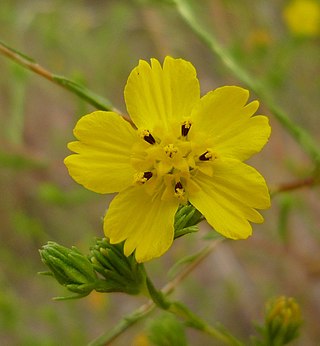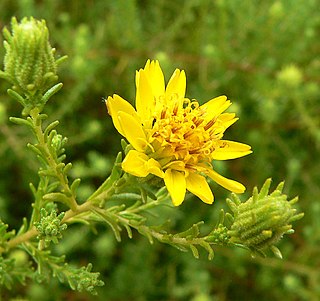
Guadalupe Island is a volcanic island located 241 kilometres off the western coast of Mexico's Baja California Peninsula and about 400 km (200 nmi) southwest of the city of Ensenada in the state of Baja California, in the Pacific Ocean. The various volcanoes are extinct or dormant. In 2005 Guadalupe Island and its surrounding waters and islets were declared a biosphere reserve to restore its vegetation and to protect its population of marine mammals and birds. The island is a popular destination for great white shark cage diving. Guadalupe Island is inhabited only by scientists, military personnel operating a weather station, and a small group of seasonal fishermen. The island is mostly arid and has very little surface water.

Hemizonia congesta, known by the common name hayfield tarweed, is a species of flowering plant in the family Asteraceae, native to western North America.

Deinandra is a genus of flowering plants in the tribe Madieae within the family Asteraceae. Such a genus is not recognized as distinct by all authorities; its species are often treated as members of the genus Hemizonia.
Deinandra bacigalupii is a rare species of flowering plant in the family Asteraceae, known by the common names Livermore tarplant and Livermore moonshine. It is endemic to Alameda County, California, where there are only about five known occurrences around Livermore. It grows in open areas with alkali soils, such as alkali sinks and meadows. This plant was previously included within Deinandra increscens ssp. increscens, but it was separated and elevated to species level in 1999.

Deinandra conjugens is a rare species of flowering plant in the family Asteraceae known by the common names Otay tarplant and Otay tarweed. It is native to a small section of far northern Baja California in Mexico, its range extending north into San Diego County, California, in the United States. One isolated population has been reported from the hills east of Cayucos in San Luis Obispo County.
Deinandra increscens is a species of flowering plant in the family Asteraceae known by the common name grassland tarweed. It is endemic to California, where it has been found primarily in Monterey, San Luis Obispo and Santa Barbara Counties. A few isolated populations have been reported from Kern and Merced Counties, but these are from urban areas and probably represent cultivated specimens.

Deinandra fasciculata, known by the common names clustered tarweed and fascicled spikeweed, is a species of flowering plant in the family Asteraceae native to western North America.

Deinandra minthornii — — is a rare California species of flowering plant in the family Asteraceae known by the common name Santa Susana tarplant, or Santa Susana tarweed. It is listed as a rare species by the California Department of Fish and Wildlife and on the California Native Plant Society Inventory of Rare and Endangered Plants of California.

Deinandra mohavensis, commonly known as Mojave tarplant or Mojave tarweed, is a species of flowering plant in the family Asteraceae.
Deiandra arida, also called Red Rock tarplant, is a rare California annual plant in the family Asteraceae.

Centromadia parryi, the pappose tarweed, is a species of plant in the tribe Madieae within the family Asteraceae. It is found in North America where it is native to California and, northern Baja California.
Deinandra corymbosa is a rare North American species of plants in the tribe Madieae within the family Asteraceae. A common name is coastal tarweed.
Deinandra palmeri is a rare North American species of plants in the tribe Madieae within the family Asteraceae.
Deinandra streetsii is a rare North American species of plant in the tribe Madieae within the family Asteraceae.
Deinandra martirensis is a rare North American species of plants in the tribe Madieae within the family Asteraceae.

Deinandra kelloggii, Kellogg's spikeweed or Kellogg's tarweed, is a North American species of plant in the tribe Madieae within the family Asteraceae. It is native to Baja California, southern and central California, and Arizona.
Deinandra halliana, or Hall's tarplant, is a California species of plants in the tribe Madieae within the family Asteraceae. It has been found in the Coast Ranges of Central California, in Monterey, Fresno, San Benito, and San Luis Obispo Counties.
Deinandra pallida, the Kern tarweed, is a California species of plants in the tribe Madieae within the family Asteraceae. It has been found in the Coast Ranges, southern San Joaquin Valley, and Sierra Nevada foothills in Kern, Los Angeles, Santa Barbara, San Luis Obispo, Tulare, and Kings Counties. Isolated populations have been reported from farther north in Tuolumne County and northwestern Fresno County.

Ericameria parishii, or Parish's rabbitbrush, is a western North American species of flowering plants in the family Asteraceae.
Dudleya virens subsp. extima is a subspecies of succulent plant in the family Crassulaceae commonly known as the Guadalupe green liveforever. It is a rosette-forming leaf succulent, with both green and white waxy foliage. It has white flowers with spreading petals that bloom from May to June. It is a somewhat small plant, continuing a southward trend of decreasing size relative to other Dudleya virens subspecies. This plant is endemic to Guadalupe Island in the eastern Pacific Ocean, which is 241 kilometers off of the Baja California coast. It is very rare, with this plant only surviving on sheer cliff faces and canyons, out of the reach of the former feral goat population rampant on the island. It closely resembles a miniature version of Dudleya virens subsp. virens, but it may be more nearly related to the local Dudleya guadalupensis.









